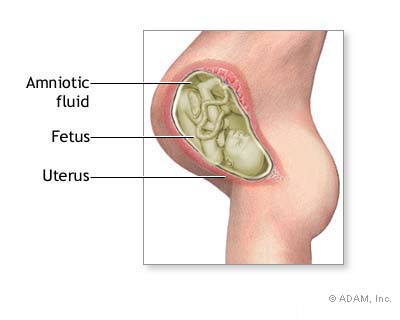Amniotic Fluid
Nature protects the unborn child with amniotic fluid. The baby is vulnerable to Temperature extremes and bumping and it is very crucial in the development and safety of a fetus. A first trimester ultrasound is often done to check for many things. It can check for
ectopic pregnancy
or
molar pregnancy.
also see
vaginal ultrasound.
The baby needs the fluid in just the right amount. Too little ( oligohydramnios ) and the baby can't move properly, too much ( polyhydramnios ) and it could be a sign of other problems. The baby also needs the fluid for lung development, and contains cells shed from the fetus and from the placenta.

An amniocentesis is the test done to check amnionic fluid. It is done at about week 15 to week 20. It screens for birth defects, heart problems and can tell the sex of the baby. It is done by gently inserting a needle through the belly and into the uterus. About two tablespoons of the fluid is taken. Called the biophysical profile or ( Bpp ) it can detect a heart problem, diabetes, and multiple birth pregnancies. See
twins ultrasound
This test is called up because of several risk factors. A close family member may have a genetic problem, an abnormal ultrasound test result from the mother, an abnormal triple or quadruple screen test (alpha-fetoprotein, estriol, human chorionic gonadotropin, hormone inhibin A). As always, we try to inform you and your doctor should guide you through the screen of
amniotic fluid. back to pregnancy ultrasound
Genesis ultrasound machine Home Page
Sources: Illustration from NY-times-adam
Sandy Jocoy, RN
Relman, D. PLoS ONE.
News release, Stanford University Medical Center.




